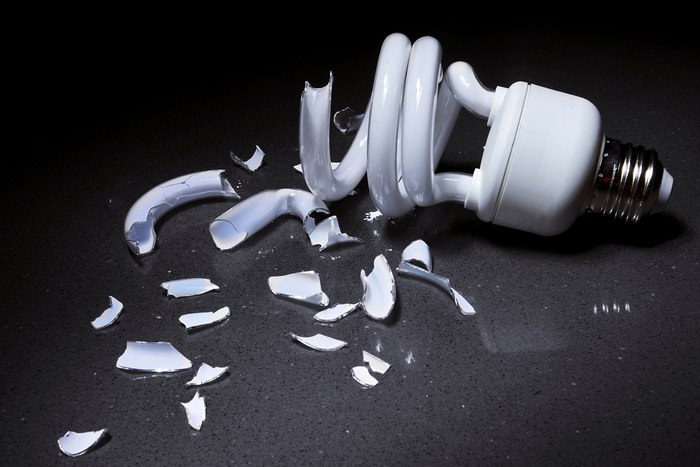Why Mercury Lamp is Harmful to Health ?

A mercury-vapor lamp is a gas-discharge lamp that uses an electric arc through vaporized mercury to produce light. The arc discharge is generally confined to a small fused quartz arc tube mounted within a larger borosilicate glass bulb. The outer bulb may be clear or coated with a phosphor; in either case, the outer bulb provides thermal insulation, protection from the ultraviolet radiation the light produces, and a convenient mounting for the fused quartz arc tube. They are used for large area overhead lighting, such as in factories, warehouses, and sports arenas as well as for streetlights.
Many light bulbs on the market contain elemental mercury. All HID (high-intensity discharge) light bulbs including metal halide and high-pressure sodium light bulbs contain certain levels of mercury. 250-watt metal halide and high-pressure sodium light bulbs contain 38 mg and 15 mg of mercury respectively. Even fluorescent light bulbs contain around 5 mg of elemental mercury regardless of wattage.
When the lamp is cold (i.e. at room temperature) metallic droplets of mercury can be seen in the lamp bulb. During operation of the lamp the mercury vaporizes due to heating of the discharge tube (lamp body). The temperature of the discharge tube reaches approximately 800°C. After the lamp is in thermal equilibrium (5 to 10 minutes after ignition), the vaporized mercury gives rise to a pressure of 30 to 75 times the atmospheric pressure.
Health hazards
Inhaling mercury vapour or small particles of mercury or its compounds can be harmful to lungs, kidneys and the nervous system. Injuries to health can also arise due to penetration of the skin or resorption via the gastro-enteric tract.
Extended Exposure
Overexposure to the elemental mercury in certain types of light bulbs can be fatal. Extended exposure to mercury can result in respiratory or kidney failure. Death can also be a side effect of overexposure to elemental mercury. People that have been exposed to any level of mercury should seek medical help immediately.
Lamp breakage
In the rare case that short arc lamps break or burst and the mercury content is released, the following actions should be taken:
1. All personnel should leave the surrounding area at once, to ensure that no mercury is inhaled.
2. Prevent access by locking the door or if not possible put a notice on the door to prevent others entering.
3. The area should be ventilated thoroughly.
4. After the lamp housing has cooled, any mercury residue should be collected using a syringe or Pasteur pipette and collected into a sealable container.
Disposal of mercury lamps
Mercury is considered Toxic [H6] and therefore lamps must be treated as hazardous waste.
Many light bulbs on the market contain elemental mercury. All HID (high-intensity discharge) light bulbs including metal halide and high-pressure sodium light bulbs contain certain levels of mercury. 250-watt metal halide and high-pressure sodium light bulbs contain 38 mg and 15 mg of mercury respectively. Even fluorescent light bulbs contain around 5 mg of elemental mercury regardless of wattage.
When the lamp is cold (i.e. at room temperature) metallic droplets of mercury can be seen in the lamp bulb. During operation of the lamp the mercury vaporizes due to heating of the discharge tube (lamp body). The temperature of the discharge tube reaches approximately 800°C. After the lamp is in thermal equilibrium (5 to 10 minutes after ignition), the vaporized mercury gives rise to a pressure of 30 to 75 times the atmospheric pressure.
Health hazards
Inhaling mercury vapour or small particles of mercury or its compounds can be harmful to lungs, kidneys and the nervous system. Injuries to health can also arise due to penetration of the skin or resorption via the gastro-enteric tract.
Extended Exposure
Overexposure to the elemental mercury in certain types of light bulbs can be fatal. Extended exposure to mercury can result in respiratory or kidney failure. Death can also be a side effect of overexposure to elemental mercury. People that have been exposed to any level of mercury should seek medical help immediately.
Lamp breakage
In the rare case that short arc lamps break or burst and the mercury content is released, the following actions should be taken:
1. All personnel should leave the surrounding area at once, to ensure that no mercury is inhaled.
2. Prevent access by locking the door or if not possible put a notice on the door to prevent others entering.
3. The area should be ventilated thoroughly.
4. After the lamp housing has cooled, any mercury residue should be collected using a syringe or Pasteur pipette and collected into a sealable container.
Disposal of mercury lamps
Mercury is considered Toxic [H6] and therefore lamps must be treated as hazardous waste.

